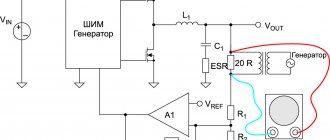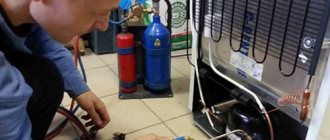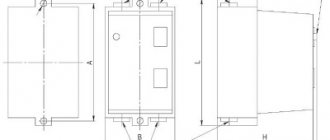Push-button control stations – devices that are produced in the form of a rectangular or square case made of durable plastic or metal with built-in control elements (two or more).
The functionality and design in different models may differ, but all devices perform the main task - transmitting alternating current through circuits with voltages up to 600 V (at a frequency of 50, 60 Hz), thereby providing signals for changing the operating mode of the units.
The devices are also used in electrical networks with direct current up to 400 V, and settings can be changed either permanently or remotely. Most often, push-button remote controls are used to transfer power to magnetic starters, which are an element of the control circuit of electric motors.
Main functions of the devices:
- turning equipment on and off;
- emergency shutdown in manual mode;
- changing rotor rotation parameters.
Advantages of using push-button posts:
- the ability to control the unit without leaving the workplace;
- there is no need to endanger life by getting close to equipment connected to high voltage;
- you can choose any set of buttons, which optimizes the control process;
- reliable operation;
- compact cases made of durable material;
- safety of use, high degree of protection;
- long operational period.
Design features and principle of operation
The design part depends on the type of model, but in any case it is practical and reliable in use. On one edge of the switching device there are power contacts that switch operating modes (on/off) or completely stop in an emergency. An electromagnetic coil is mounted in the opposite part, ensuring the process of closing/opening contacts.
The remote control structure includes the main elements:
- control panel buttons (“start-forward”, “start-back”, “stop”);
- coils of magnetic starters (KM1, KM2);
- contacts of magnetic starters (KM1.1… KM2.3).
The operating principle of push-button posts is as follows. When you press “start-forward”, power is supplied to the coil of the first magnetic starter (KM1), as a result of which the group of open contacts closes, supplying current to the windings of the electric motor.
“Start-back” disconnects the contacts, blocking the connection of the magnetic starter coil (KM2). When you press the “stop” button, the power supply to KM1 and KM2 is stopped, thereby de-energizing the electric motor. The “start-reverse” pusher operates similarly to the “stop” button, but only in relation to the second magnetic starter (KM2).
When you press “start-forward”, power is supplied to the coil of the first magnetic starter (KM1), as a result of which the group of open contacts closes, supplying current to the windings of the electric motor
Post types
There are many different push-button remote controls on the electrical equipment market that can be used to control equipment and machines. It is worth noting that the differences between many of them can be traced mainly in the design of the case and the brand, while the functionality and design of many are completely identical.
Therefore, from the manufactured devices, only the main ones with justified technical differences are distinguished:
- PKE, with the help of which the control of metal and woodworking units for industrial and household purposes is carried out;
- PCUs intended only for industrial equipment where there is no threat of explosion;
- PKT used for units with a lifting and loading mechanism.
Types of push-button control panels
Rice. 3. Series designation “PKE”
Today, on the electrical equipment market, a fairly large number of different push-button remote controls are produced that control electrical equipment.
However, functionally and structurally, they are all identical and differ in design and brand. All model lines of this type of electrical fittings can be supplied in various placement categories and different designs.
Typically, these two parameters are reflected in the symbol of a specific model. Russian enterprises produce the PKE, PKT and PKT series for installation in industrial equipment control systems.
The PKE series has found the widest distribution in control circuits of wood and metalworking machines and industrial complexes.
The permissible operating parameters of these devices are as follows:
- Maximum value of switching voltage: constant – 400.0 volts; alternating (frequency 50.0 or 60.0 hertz) – 660 volts;
- Switching current – 10.0 amperes;
- Maximum number of actuation cycles – 5×106.
The symbol for push-button stations of the PKE series is shown in Figure 3, in which the following characteristics are indicated by numbers:
- 1 – serial number designation;
- 2 – characteristics of the installation method (built-in or overhead);
- 3 – degree of protection category;
- 4 – body and panel material (metal or plastic);
- 5 – number of controlled contacts (the figure shows the designation for two contacts);
- 6 – a parameter indicating product modernization;
- 7 – category of accommodation and the corresponding climatic modification.
Rice. 4. Designation of the “PKU” series
Posts of the PKU series are intended for operation in an explosion-proof environment where the concentration of dust or gas will not impair their functionality.
The fittings have operational parameters similar to the PKE model line, however, the manufacturer has provided its own designation for this electrical fittings, which is shown in Figure 4.
The digital designations shown in the figure correspond to the following parameters, which allow you to characterize a specific device model:
- 1 – serial number designation;
- 2 – serial modification number;
- 3 – rated current switched by contacts of a separate button;
- 4 – the number of pushers installed in horizontal rows;
- 5 – the number of pushers installed in vertical rows;
- 6 – installation method (overhead, built-in or suspended);
- 7 – degree of electrical protection;
- 8 – category of accommodation and the corresponding climatic modification;
Fig.5 – PKT remote control
The PKT series is designed to work with electrical equipment of lifting mechanisms (electric hoists, overhead cranes and overhead cranes) with ground-based, manual control.
Operational and electrical parameters are similar to devices of the “PKE” and “PKU” series. Under the abbreviation “IEK”, Chinese fittings are sold on the Russian market of electrical products, whose characteristics are completely similar to Russian control posts.
The general view of this electrical fittings is shown in Figure 5.
In the designation “PKT-X1 X2 X3” the digital indices characterize the following parameters:
- X1 – series number;
- X2 – number of control buttons;
- X3 – placement category and corresponding climatic modification.
Explosion-proof starting fittings
KPVT control panel
Russian explosion-proof valves have in their letter designation an additional index “B” - “PVK”, or “KPVT”. They are most widespread in control circuits for electrical equipment operating in explosive environments in coal mines, oil storage facilities, paint shops and other similar facilities.
Hoist push-button controls “HAS-A” (“Schneider Electric” - Germany) and “KS” (“SN Promet” - Poland) are widely used. In addition, remote push-button control valves are becoming increasingly common in this category.
Main characteristics and operating conditions
Despite the fact that the technical characteristics of the models are identical, differences in parameters are still observed:
- with alternating current, the lowest operating voltage is 36 V, with direct current – from 24 V;
- rated voltage with alternating current is up to 660V, with direct current – up to 440V;
- rated voltage supplied to the insulating layers is within 600-660 V;
- four types of nominal operating modes (long-term, intermittent-long-term, short-term, intermittent);
- rated current is 10A;
- For 1 second, a through current with a nominal value of 200A flows through the push-button post.
The posts operate in various areas, which are located no higher than 4300 m above sea level
Rules for operating control devices
Many models are not designed to work in explosive environments, so you should familiarize yourself with the technical specifications before purchasing. The operating temperature in the room or workshop should be within -35 – +40°C.
The posts operate in various areas, which are located no higher than 4300 m above sea level.
To ensure long-term operation of the devices, it is necessary to monitor the humidity of the environment (50% is considered an acceptable indicator). An increased level of moisture affects the condition of the contacts and disables them. In addition, it is important to monitor the degree of dust and gas contamination in the room. Large amounts of dust and gases can cause fire or smoke.
During operation of the post, do not allow the body to be exposed to sunlight, this will lead to overheating of the device.
Lighting fittings
The most popular in our time is LED fixtures based on semiconductors - these technologies can no longer be called innovative, but they are the most progressive of the developed ones. LED lamps, indicators, signal lights, etc. provide truly bright lighting, have a very long service life, are reliable and require almost no repairs. In addition, as is known, these are very economical devices to operate.
The shape, size and design of lighting devices are varied. Complex products can contain not only lamps, but also displays that demonstrate certain indicators that exist on the device at the current moment in time. Some sirens operate simultaneously in both sound and flickering, pulsating light signal modes, which allows you to attract attention from a greater distance and much faster.
Post models
The XACA28131 pushbutton station (Schneider Electric) is a suspended model with a polypropylene body. The device is designed to control a single-speed motor of lifting equipment. There are 2 buttons and one emergency stop on the case. Mechanical wear resistance is 1,000,000 cycles, but with proper maintenance and proper operation the device can last longer. The cost of the remote control is 4815 rubles.
The XACA49141 control panel (Schneider Electric) is a suspended structure with a polypropylene housing. The device is designed to be connected to a two-speed motor of a lifting machine. The model is equipped with 4 buttons and one emergency stop. The rated operating power is 65 W, which corresponds to a wear resistance rating of 1,000,000 cycles. The cost of the post is 8014 rubles.
Push-button station PKT-61 (IEK) has 2 built-in buttons (without fixation). Model protection degree – IP54, rated voltage up to 400 V at alternating current. The body is made of plastic. The cost is 430 rubles.
Model PKE 212/3 (Russia) has a plastic case with two control buttons (without fixation) and one emergency shutdown. Rated voltage – 440V/660V. The degree of protection corresponds to IP40. The cost of the device is 162 rubles.
The XACA6814 post (Schneider Electric) has a suspended structure, the body is made of polypropylene. The device is equipped with 6 buttons and one emergency shutdown. Mechanical wear resistance is at least 1,000,000 cycles. Rated voltage - 600 V. Model cost - 7155 rubles.
Cost indicators
The cost of Russian push-button posts is quite low and depends primarily on the number of buttons , category of placement and climatic design. Devices in a metal case are slightly more expensive than analogues installed in a plastic case.
For example, the price of two-button devices “PKE-222-2” is in the range of 250.0...280.0 rubles. A similar device with a mushroom-shaped “Stop” button will cost a little more – 380.0 rubles.
The price of one-button posts does not exceed 150 rubles. The six-button telpher remote control “PKT-60” costs 300.0 rubles. A device with a similar number of buttons and electrical parameters, equipped with a key (“foolproof”), will cost 200.0 rubles more.
Blitz tips
- Correct operation of posts is associated with proper selection of devices. All technical specifications must correspond to the parameters of the equipment to which the connection is made.
- The body of the push-button device is made of non-flammable materials , but this does not mean that the device can be placed during operation with heating sources or under sunlight. Additional heat supplied to the contacts will cause them to overheat.
- Russian-made posts that relate to explosion-proof fittings are supplemented with letter designations: “B”, “PVK” or “KPVT”.
- In modern models, a special role is played by the button that acts as a pusher. It is designed in two versions: with position fixation and self-return. When choosing, it is worth considering the features of the technological process to optimize control.
- It is better to purchase posts in specialized stores or from an official representative. This ensures warranty service and reduces the risk of system failure during operation. A conscientious manufacturer values its reputation, so before going on sale, products undergo high-quality testing.










